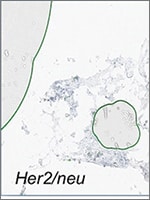December 2023—Digital pathology and AI—the push, the potential, the changing questions, the reimbursement, and the caution. All that and more came up when CAP TODAY publisher Bob McGonnagle on Oct. 17 led a conversation online with pathologists and industry representatives.
Read More »Savings follow allergy, autoimmune test consolidation
December 2023—Hoi-Ying Elsie Yu, PhD, D(ABCC), isn’t new to workflow optimization. As system director of chemistry, point-of-care testing, and preanalytics for Geisinger Medical Center in Danville, Pa., for the past decade, she has undertaken initiatives to maximize efficiency in complicated parts of the laboratory whenever she can.
Read More »Test adds twists to lung disease diagnosis
November 2023—It was a mystery, wrapped less in an enigma than a few layers of bafflement, surprise, and mild irritation. Call it the Case of the Split Lung Specimens. The first hint something was amiss came when Alain Borczuk, MD, vice chair of anatomic pathology and co-director of thoracic pathology, Northwell Health, noticed that he and his colleagues were receiving more insufficient bronchoscopy specimens than usual. “When I say ‘increasing’—we don’t get that many bronchoscopies. It’s not like colon polyps,” says Dr. Borczuk, who is also director of oncologic pathology, Northwell Health Cancer Institute. Normally they would get a handful a week, some of them straightforward cancer cases, although these additional cases were tied to noncancerous conditions. And then the plot thickened even further, with missing pieces—literally. Though no guideline clearly states what constitutes an adequate specimen, Dr. Borczuk says, the samples he and his colleagues were seeing fell markedly short.
Read More »Generative AI, from education to corner cases
Generative artificial intelligence—what it is, how it can be used in pathology, what stands in its way, why the excitement. CAP TODAY publisher Bob McGonnagle spoke about that and more with pathologists Bobbi Pritt, MD, MSc, and Scott Anderson, MD; Ajit Singh, PhD, of Stanford and Artiman Ventures; and Devon Snedden, a health care consultant in artificial intelligence. “There are a lot of excellent possibilities that we’re just starting to understand and explore for the field of pathology,” said Dr. Pritt of Mayo Clinic.
Read More »AI-driven spatial biology: the next next-gen sequencing
November 2023—Spatial biology may be an emerging field, but Kenneth Bloom, MD, says he and other pathologists have been doing it “since we got the microscope.” And he argues it’s going to become “the new, most important lens we look through.” The reason is the emergence of new cancer treatments like immunotherapy and, most importantly, antibody drug conjugates like Enhertu, says Dr. Bloom, head of pathology for Nucleai, a company specializing in AI-powered spatial biology.
Read More »Minds shift on digital path, ‘massive change’ predicted
Is digital pathology on the move? Two who know it well say it is. Esther Abels, a precision medicine and biomedical regulatory health science expert who is CEO of SolarisRTC and former president of the Digital Pathology Association, and Michael Rivers, vice president/lifecycle leader of digital pathology at Roche Tissue Diagnostics, spoke in September with CAP TODAY publisher Bob McGonnagle, who got their take on where things stand.
Read More »Reports revisited—panel on preferences and pain points
November 2023—Reports—integrated or otherwise—were up for discussion when CAP TODAY publisher Bob McGonnagle convened online in October a group of informatics experts, who spoke of the need for simplicity in a time of growing complexity, ease of access, where Epic isn’t strong. The full conversation follows.
Read More »Digital path’s star rises from the mists
October 2023—In living up to its promise as a new technology that will revolutionize clinical care through greater ease, speed, and accuracy of diagnosis, digital pathology has been sluggish. While many analysts, starting at least two decades ago, forecasted that digital pathology would elbow aside glass slides for good, that milestone is still far out of reach. As health economist and chief executive officer of the New York City-based digital pathology company Paige, Andy Moye, PhD, puts it bluntly: “In probably 90 to 95 percent of the cases in the U.S., a pathologist still makes the diagnosis of cancer the way they did it back in 1910: by looking at a glass slide under a microscope.” Mark Lloyd, PhD, vice president of pathology for Fujifilm, says he wouldn’t be surprised to hear that perhaps only five percent to 10 percent of hospitals have moved beyond using only glass slides to offer pathologists digital pathology capability. In fact, Dr. Lloyd thinks those percentages are overstated. What is the market share for the clinical use of digital pathology?
Read More »Workflow, specimen transport under the lens at AACC
June 2023—Transporting specimens to the laboratory, and processing and distributing them within the lab, will be what AACC meeting-goers hear about in a session next month.
Read More »‘Doing more for less and with less’: Turning to IT
February 2023—As this year’s guide to anatomic pathology computer systems was taking shape, CAP TODAY publisher Bob McGonnagle met online with representatives of five companies and with John Sinard, MD, PhD, of Yale University School of Medicine. They talked about the cloud, CPT codes, training of pathology informaticians, and artificial intelligence, for which the time frame in pathology is far longer than it’s been portrayed, in Dr. Sinard’s view. “It will start to impact the careers of some of our trainees, but it’s probably a 10- to 20-year time frame before it plays a major role,” he said. The view of Joe Nollar of Xifin: “Speculation that AI will someday replace pathologists is completely overblown,” though it will help to triage cases and mitigate risk. Their full conversation, which took place Dec. 20, 2022, follows.
Read More »Autoverification: lessons drawn from a core lab
August 2022—Just as there is scant room in this world for pink “While You Were Out” notepads, paper checks, or the copying skills of Bartleby the Scrivener, laboratories would do well to leave manual result verification in the past.
Read More »Histology lab tips for top-tier whole slide images
July 2022—Good slides in, good images out. Liron Pantanowitz, MD, MHA, explained how to get those good images in a recent webinar on preanalytics quality control in digital pathology, sponsored by Sunquest and made available by the Association for Pathology Informatics.
Read More »A look ahead at AI-based assistance in anatomic pathology
February 2022—In a survey of the international pathology community on the integration of artificial intelligence into diagnostic pathology practice, 80 percent of the 487 respondents predicted integration within the next five or 10 years.
Read More »A gap in need of a fix: EHRs and genomics
January 2022—“Workflow” evokes a process that moves smoothly, like water, that doesn’t break down or grind to a halt, a sequence of steps that can be completed in a seamless manner. Genomic workflows in information systems, however, have an especially poor fit with the concept of “flow.” As genomic data migrate from the laboratory to an electronic health record or from one EHR to another, significant gaps can result between generation, interoperability, and utilization that may lead the data to miscommunicate or mislead. “The technology behind next-generation sequencing and genetic testing in general has advanced by leaps and bounds over the last 10 to 15 years,” says Alexis Carter, MD, physician informaticist, pathology and laboratory medicine, Children’s Healthcare of Atlanta. While the use of genomic testing has expanded rapidly, “information systems and electronic health records have really not been able to keep up.”
Read More »DELFI approach as ‘pretest’ in early cancer detection
December 2021—A cost-effective liquid biopsy focused on analyzing genomewide fragmentation profiles in cell-free DNA has been shown in proof-of-concept studies to detect early-stage lung and other cancers.
Read More »New hope for lab data interoperability
November 2021—Interoperability, a problem of long standing in health care, has a new push and new prospects. Interoperability has become a front-burner issue because it has become increasingly urgent to bring the standardized communication of health care data up to speed.
Read More »For genomic testing, a homegrown software solution
November 2021—At NorthShore University HealthSystem in suburban Chicago, a homegrown bioinformatics solution is the “secret sauce” that powers the health system’s personalized medicine program, says Kamalakar Gulukota, PhD, MBA, director of NorthShore’s Center for Bioinformatics and Computational Biology.
Read More »How to prevail over a crisis using data analytics
September 2021—The pandemic has pelted hospitals and laboratories with wild cards and sometimes thrown wrenches into the works. But the jolts it has delivered to normal institutional operations, forcing new solutions to business and clinical care dilemmas, have also positioned laboratories to help produce stunning new capabilities.
Read More »AP lab maps its cyberattack recovery
August 2021—The downtime manual that the anatomic pathology laboratory at the University of Vermont Medical Center maintained in 2020 was never intended to be used for dealing with a cyberattack. In fact, it wasn’t actually a manual. It was a laboratory-wide policy essentially consisting of one instruction to be used in the event of a power failure or short-term IT disruption or other emergency: “Bring everything to a halt.” In anatomic pathology, “Our downtime protocol was: You stop in your tracks,” says dermatopathologist Anne M. Stowman, MD. “For the urgent/emergent specimens, you get out your paper logs, you do paper recording of the cases coming in, and you handwrite your cassettes, your descriptions, your slides.” That would be a bit slower and less efficient, but it would work for brief, temporary outages and disruptions. But the cyberattack that UVMMC experienced in October 2020, cutting off the labs’ access to the medical center’s information technology systems and disabling operations for more than three weeks, was an abrupt wake-up call.
Read More »National patient identifier advocates state their case
August 2021—The iconic Timex slogan “It takes a licking and keeps on ticking” was designed to sell watches in the 1950s and ’60s, but it could just as easily be applied to efforts to repeal the decades-long appropriations ban on a unique national patient identifier—year, after year, after year.
Read More »Close ties: instruments, middleware, and more
July 2021—Laboratory instrumentation from an IT perspective and as one solution to the labor shortage were the topics explored April 27 in a virtual roundtable of instrument vendors and laboratory medical directors, led by CAP TODAY publisher Bob McGonnagle. Part one of their conversation about core labs was published in the June 2021 issue; part two follows.
Read More »Virtual, blended inspections a sign of the times
June 2021—As COVID-19 restrictions halted traditional laboratory inspections, virtual and blended inspections became the stand-ins, and early adopters say there’s much to like and hold on to post-pandemic.
Read More »On the frontline of health care cybersecurity
May 2021—In the best of times, the health care industry has been the one most targeted by cyberattacks in the past decade. The pandemic has made health care an even more inviting mark, increasing the urgency of adopting effective cybersecurity measures.
Read More »Weeks of lab turmoil follow cyberattack
April 2021—After he finished interviewing for a fellowship one morning last October at the University of Vermont Medical Center, pathology resident William O. Humphrey, MD, checked in to attend grand rounds virtually. Then the cyberattack struck. It began mysteriously, with people dropping one by one off the Zoom screen and emails arriving only intermittently. Internet service grew patchy and a hospital staffer unmuted and canceled grand rounds, saying, “We aren’t really sure what’s going on.” From there, a cascade of failures indicated serious trouble. “All of a sudden we’re realizing we can’t sign into our EMR. We can’t get into our email either. My phone isn’t working on the Wi-Fi. Something is wrong,” recalls Dr. Humphrey, a member of the CAP Informatics Committee. That was the prelude to a siege in which fax machines and penmanship were unretired from obsolescence, paperlessness became a relic of the past, and words like “runners” and “bouncers” entered routine laboratory vocabulary.
Read More »SARS-CoV-2 testing: Buy, build, and borrow? Middleware solutions
April 2021—Whirlwind timelines, novel problems, and a never-ending workload: On the anniversary of the COVID-19 pandemic, pathology informatics leaders David S. McClintock, MD, and Christopher Williams, MD, reflected on the year’s onslaught of challenges.
Read More » CAP TODAY Pathology/Laboratory Medicine/Laboratory Management
CAP TODAY Pathology/Laboratory Medicine/Laboratory Management










